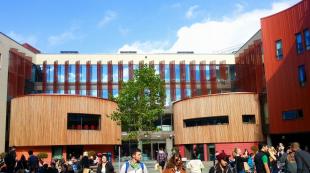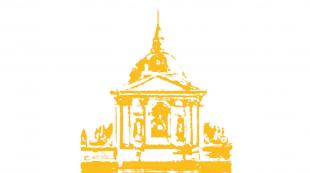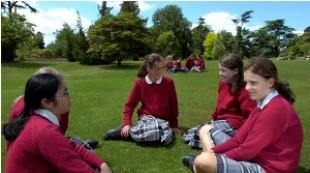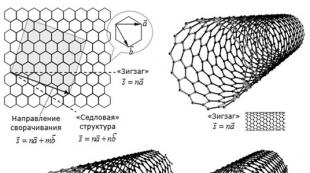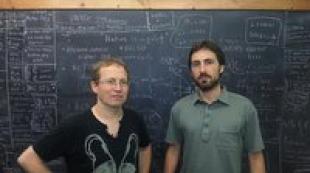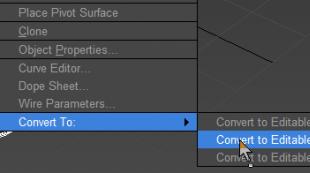Letter and - occupation, games. Abstract of a lesson in preparation for teaching children of the preparatory group to read and write. Acquaintance with the consonant sound, the letter Y Task: printed letter Y for preschoolers
And again for you rubric learn letters. As you guessed correctly, today we have a consonant letter "Y". Why consonant? And make a sound. So how easy is the sound? Of course, it meets obstacles, the tongue and teeth interfere.
At the beginning of a word you will meet this sound not so often, but in the middle and at the end of the word as much as you like. So start with, come up with words with the sound "Y". Lay out or sculpt a letter.
I'm just offering to help you practical material: art word, games, tongue twisters, riddles.
Letter "Y"

Merry Poems
| Iodine is good, iodine is not evil. In vain you scream: "Oh-oh-oh!" - Slightly seeing a bottle with iodine. Iodine sometimes, of course, burns, But heal faster Iodine smeared wound. V. Lunin A bird flies over the gate, But he does not sit on the gate. E. Tarlapan I have a needle and thread I learn to sew from my mother. If I prick my finger I will fill the wound with iodine. |
Oh-oh and ay-ay - Oh oh oh! – said Oh-oh. - I, my friend, am quite big! - You go, take a walk, All will pass! - said Ay-ay. G. Vieru Because the comma Sitting on her shoulders. V. Kozhevnikov Yogi Ivan would help May a yogi live beyond the sea. |
Patter
Distressed magpie
Returns from class.
The whole lesson chatted with the jay
And returned home with a deuce.
Proverbs and sayings
1. Do not have a hundred rubles, but have a hundred friends.
2. Make new friends, but don't lose old ones.
3. Don't be afraid of the cold. Wash up to your waist.
Games
The game "Who is more."
Think of words with the sound [y] at the beginning (iodine, yogi, iota), in the middle (T-shirt, watering can, snake), at the end of a word (May, tea, edge).
The game "Transformation of words."
Change the words so that they indicate a request, an order, a call to action: worth ( stop), washes ( my), builds ( system), sings
(sing), decides ( decide), plays ( play), repeats ( repeat), floats ( swim), thinks ( think).
The game "Where is the sound."
The teacher invites the children to determine the position of the letter "y" in the words: strong, jockey, puck, iodine, ruler.
The game "Recognize the sound."
Clap your hands once if you hear the sound [th] in the words: fox, husky, player, face, washbasin, nightingale, bus, trolleybus, scissors, car, snake, name, tea.
Game "Tell me a word".
Game Curious.
- What is your name? (Andrey.)
- What do you like for breakfast? (Egg.)
- What type of transport do you prefer? (Tram, trolleybus.)
Where do you like to go on your day off? (To the museum.)
What do you use to collect water to water the flowers? (Into the watering can.)
- What fruit do you like? (Ivo.)
– What drink do you like? (Tea.)
The game "The letter is lost."
Insert the missing letters in the words:
sha - ba, hero -, tram -, study - those.
The game "Transformation of words."
1. Insert missing letters into words:

Answer: T-shirt, nut, bunny, husky, gang;
watering can, rail.
2. Change each word so that it contains the letter "y".
Builder ( construction), cast ( watering can), Hare ( Bunny), reader ( read), winter ( winter).
Game "Entertaining models".
Make up words according to the following patterns.
1. - - th (May, bark, tea, howl, fight.)
– – th – – (T-shirt, T-shirt, seagull, jay, nut.)
2. - - ai (Edge.)
- - - ah (Shed, deprive.)
– – – – ah (Custom, occasion.)
- - - to her (Museum, lyceum, jockey, wheatgrass.)
Puzzles
Well, my dears, yours practical advice replenished with one more letter, this letter "Y".
The purpose of the lesson: we study the letter Y, the formation of reading skills, the development of speech skills, the improvement of phonemic hearing, the basics of an elementary graphic skill.
- to introduce the preschooler to the letter Y, the correct pronunciation of the sound;
- to teach to write the capital letter Y in the cells;
- to form an interest in learning with poems and riddles.
Name what is shown in the pictures below:
Kettle Parrot Yoghurt Yog
- Please listen to the words (highlight the last sound with your voice): mine, yours, wild, kind, smart.
- What is the sound in all these words?
- What sound is there in both the word PARROT and the word MIKA?
- At the beginning, at the end or in the middle of the word sound [Y] in the word PARROT? - MIKE? - GIVE? - AIBOLIT?
When we pronounce the sound [Y], the tip of the tongue is behind the lower teeth, and the back of the tongue rises to the palate. Say: YYY. The back of the tongue rises to the palate and prevents the air from leaving the mouth freely when we pronounce the sound [Y].
- Vowel or consonant sound [Y]?
- Voiced or deaf?
- Why?
- Consider the letter Y. What letter does it look like?
The letters are similar, but the sounds are completely different: [I] is a vowel, and [Y] is a consonant.
Repeat: BUNNY. What is the first syllable in this word?
What is the second syllable in this word?
Similarly - with the words MIKE, SMART, STUPID, TRAMS, AIBOLIT.
Read the words:
my, May, smart, kind, red, hero, bunny, stupid, strong, green, funny, tram-wai.
Activity: Print Y for preschoolers
Consider the letter Y. We sewed the letter Y in the air and once in a notebook carefully in the cells with a simple pencil or ballpoint pen.
In cases where a child is asked to write a whole line of a letter, syllable or word, the adult gives a sample spelling at the beginning of the line.
If a preschooler has difficulties, then an adult can draw two reference lines, or put anchor points that the child will connect with lines, or write the letters in their entirety, and the child will simply circle them in a different color. Calligraphy at this stage of training should not be required.

Continue the phrase
The house on the rails is right there.
He will kill everyone in five minutes
You sit down and don't yawn
Departs ... (tram).
What did we sing, guess?
Kara… (wai).
What did they sing to us, guess? Bayu ... (bye).
What month, guess? The month of May).
What's in the glass, guess? Sweet tea).
Tale about the letter Y
What do you know about yoga?
"What do you know about yoga?" - that was the name of the book that the little mouse Mouse found in the garden. On the cover, a naked uncle was drawn - a yogi, who, as if nothing had happened, was lying on nails sticking out of the board.
In other pictures, the same yogi simply stood with his bare feet on hot coals or sat frozen in a block of ice. In addition, the Mouse read that yogis can not eat or drink for months.
- Need to try! Mouse decided.
- I can imagine what will happen when my mother opens the refrigerator, and I sit there frozen and smiling. Or dad opens the stove, and I sit there on the coals and say: “What, you never saw yoga, or what?”
To begin with, he drove nails into the board and only lay down on them, when he immediately jumped up and let's yell at the whole garden:
Oh-ee-ee!!!
He ran home, took out iodine and began to smear his scratches from nails. And iodine burns! The Mouse smears, yells, and he himself thinks: “I’ll throw this book to the cat. Let him be a yogi now.”
Riddles for children with the letter Y
Boil - steam comes out,
And whistles and blazes with heat,
The lid rattles, knocks.
- Hey, take me off! - screams.
(Kettle)
Amazing wagon!
Judge for yourself:
Rails in the air, and he
Holds them with his hands.
(Trolleybus)
In a woolen meadow
Dancing thin-legged.
From under a steel shoe
The stitch comes out.
(Sewing machine)
It might break.
It can also weld
If you want, into a bird
Can turn.
(Egg)
Tell me who's so afraid of things
Like sticks - a dog,
Like a stone - a bird?
(Lazy person)
I run to my mother-river
And I can't be silent.
I am her own son
And was born in the spring.
(Creek)
He releases sheets
wide latitude.
Keeps on strong stems
One hundred rough, tenacious fruits:
If you do not bypass them -
You can find them all on your own.
(burr)
Grew up in the field angry and prickly,
Needles in all directions.
(burr)
I am always friendly with the world.
If the sun is in the window
I am from a mirror, from a puddle
I run up the wall.
(Sunny Bunny)
Button on the head
A sieve in the nose
One hand
Yes, it's on the back.
(Kettle)
Funny poems about the letter Y for children
Iodine is good, iodine is not evil.
In vain you scream: "Oh-oh-oh!"
- Slightly seeing a bottle with iodine.
Iodine sometimes, of course, burns,
But heal faster
Iodine smeared wound.
(V. Lunin)
Play, bunny
Play with me.
Bunny answers:
- I can't, sick!
Oh-oh-oh, poor!
(E. Blaginina)
Oh-oh-oh! - Said OH-OH.
- I, my friend, am quite sick!
- You go for a walk!
All will pass! - said AY-AY.
(G. Vieru)
A yogi will never say, "Oh!"
"Oh oh oh!" - the yogi will not shout.
Young man, control yourself!
Old, be young!
(V. Berestov)
I am on the tails of birds and animals:
Here is an ermine, here is a sparrow.
(E. Grigorieva)
At the station "And short"
We were greeted with a mystery:
"Read, dare and guess -
How, without getting up,
You can turn the tram
Many trams?
…What to skip
So that you can have a bunny
Turn into a stutterer?
One of us for three minutes
I thought about the solution
And answered "Erase the hook
Above the letter "And short".
(S. Marshak)
The ant found a blade of grass
She had a lot of trouble.
Like a log hefted on his back,
He takes her home...
He bends under the burden.
He crawls with difficulty.
But what a good
Ants are building a house!
(3. Aleksandrova)
Lesson summary:
- The pronunciation of new words increases the vocabulary of a preschooler, develops speech and memory.
- Cell exercises develop fine motor skills of the hands.
- Riddles develop in children ingenuity, the ability to analyze and prove. Educators use riddles in teaching children to increase interest during complex tasks.
- Poems affect not only the development of memory. It has been proven that if you learn several lines every day, new neural connections appear in the brain, and your overall learning ability increases.
Theme: Consonant sound [th], letter Y. New Year's adventure with the heroes of your favorite fairy tales.
Goals: acquaintance with the sound [th], denoting it with the letter Y; practicing the skill of clear pronunciation of the sound [th]; development of phonemic perception; learning the ability to distinguish the sound [th] from a number of sounds, syllables, words; make sentences with a given word; learning to read syllables according to syllabic tables and words with the sound [th]; development of memory, attention, thinking; education of discipline, ability to work in a team.Equipment: sound houses; pictures of words with sound [th] (Koschey Immortal, Emelya, Zmey Gorynych, Thumbelina, Goblin, Water); cards with windows to determine the place of sound in a word; red, blue, green lanterns with and without bells; colour pencils; pictures of a snowman, Baba Yaga, Santa Claus, Snow Maiden, Christmas tree, Christmas decorations with syllables printed on them and words with the letter Y; "Merry Train" manual.
Course progress.
I. O.n.z. Surprise moment.
-
- Hear, guys, someone sighs and calls us. Yes, this is our friend Snowman.
- What happened, Snowman?
- Oh oh oh! - Ah ah ah! Hey Hey hey!
Guys, Snowman is so scared that he can't say anything else. Who scared him so?
- Oh oh oh! - Ah ah ah! Hey Hey hey!
He probably wants to name the fairy-tale hero who scared him so much.
Let's listen again to what he says and determine which sound is repeated more often than others.
- Oh oh oh! - Ah ah ah! Hey Hey hey!
II. Introduction to a new sound.
Characteristics of sound [th] according to articulatory and acoustic features.
- That's right, it's the sound [th]. What is he?
Let's make this sound. Will we be able to sing it? What's stopping us? (Barrier - the tongue arches the back). What is this sound? (Consonant). Is it soft or hard? What do you want to do, clench your fist or stroke your palm? (soft). The sound [th] is always soft. Listen to your throat, is this sound sonorous or deaf? (voiced). Sound [th] - consonant, sonorous, always soft.
III. The development of phonemic perception.
- To find out the name of the fairy-tale hero who scared our Snowman, you need to learn how to identify the sound [th] among other sounds. What color will the magic lantern be lit when we hear the sound [th]? (green with bell)
1. Definition of sound [th] in a series of sounds.
A U Y N Y Y M P Y ...
2. Definition of sound [th] in a series of syllables.
AY OY SA MA AL AY HEY….
3. Definition of sound [th] in words.
- We learned how to determine the sound, now we can determine the name of the fairy-tale hero who scared the Snowman.
Puss in Boots, Giant, Shrek, Kikimora, Baba Yaga.
- That's right, it's Baba Yaga.
IV. Working with new sound.
Determining the place of sound [th] in a word.
- Baba Yaga hid Santa Claus and the Snow Maiden. And fairy-tale characters will help us find it, in the name of which there is a sound [th]. They will go in search of Grandfather Frost and the Snow Maiden on our Cheerful train. In the first car, those heroes will go, in whose name the sound [th] is at the beginning of the word, in the second - in the middle, in the third - at the end of the word. (Koschey Immortal, Emelya, Serpent Gorynych, Thumbelina, Leshy, Vodyanoy) All of them really want to celebrate the New Year with us.
v. Introduction to the letter Y.
- While our heroes are looking for Santa Claus and the Snow Maiden, we will prepare invitation cards for them. We know the sound [th], but what do you need to know in order to write it? The letter Y. We hear and pronounce sounds, we write and read letters.
The letter Y is called "And short."
Y as And in your notebook.
In order not to confuse Y with I,
Write a tick at the top.
VI. Working with a new letter
1. Highlighting the letter Y in the text.
- Underline all the letters Y in the invitation card. What pencil will we use to underline the letter Y? (in green)
New Year!
Koschey the Immortal, Emelya, Serpent Gorynych, Thumbelina, Leshy, Vodyanoy, come to my kindergarten for the New Year's holiday.
2. Reading syllables with a new letter.
And here is Santa Claus with the Snow Maiden. They came to us for the holiday, they brought a Christmas tree with them.
To decorate the Christmas tree, you need to read syllables and words with a new letter on the toys.
AY OY OY MY MAY
VII. Fizminutka.
The Christmas tree is dressed up, and now we will play with it. Attention game "Christmas trees big and small."
- Let's show how big the Christmas trees are (raise your hands up), and how small (put your hands down). (Children should show large and small Christmas trees, not paying attention to the deceptive movements of the speech therapist, but listening only to his verbal instructions).
VIII. Consolidation of what has been learned.
1. Vocabulary expansion.
"Change the word."
Have fun on our holiday. Baba Yaga also asks to join us. Santa Claus gave her a task, but she can't do it without us. Let's help her. Necessary
change the word so that the sound [th] appears in it: a T-shirt - a T-shirt, a hare - a bunny, a bench - a bench, a sparrow - a sparrow, an egg - an egg, a ruler - a ruler, a nightingale - a nightingale ...
2. Working with clear words.
"Read and tell":
Oh - oh - this is my bunny
Ai - ai - we baked a loaf
Ai - ai - in a cage parrot
Oh - oh - we're going home
3. Making proposals.
What words with the [y] sound did you hear? (bunny, loaf, parrot, home, mine)
Make suggestions with them.
IX. Outcome.
It's time for Santa Claus with fairy tale characters to return to their fairy tales. And the sound [th] remains with us in the city of Sounds. Let's remember what this sound is? (consonant, soft, voiced). Well done!
Correction-developing tasks.
To teach the child to listen carefully to the speech of an adult, to correctly understand the logical and grammatical constructions.
Teach your child to pronounce the sound [Y] correctly.
Improve the skills of analytical and synthetic activities, develop the child's sound-syllabic representations.
Learn to analyze sentences, find prepositions and words with a certain sound in a sentence.
Learn to transform words.
Learn to write short sentences under dictation in compliance with elementary spelling rules.
Exercise 1. Didactic exercise "What is the right way?". An adult reads a sentence to a child. The child listens carefully, determines whether the sentence is correctly or incorrectly pronounced. If a mistake is made, the child corrects it.
The cart is carrying a horse. The cat caught the mouse. The horse is pulling the cart. The mouse caught the cat. The lantern is illuminated by the street. The street is illuminated by a lantern.
Task 2. Acquaintance with the sound [Y]. An adult invites the child to listen to a series of words and name the last sound in the words:
sparrow, stream, burdock.
An adult shows in front of a mirror and explains to the child the articulation of the sound [Y]:
- lips slightly in a smile;
- teeth are close;
- the tip of the tongue behind the lower teeth, the back of the tongue is raised to the hard palate, forming a gap through which the air stream passes;
- neck "works".
Characteristic sound: consonant sound (the tongue creates a barrier to air), sonorous, solid. Designation: blue circle with a bell.
Task 3. phonetic exercise.
How do they scream in fear? - Ouch! Ouch! Ouch!
Task 4. Consider a number of drawn objects, name them, select only those in the name of which there is a sound [Y], determine the place of the sound [Y] in words:
T-shirt, fly, books, house, tea, shed, seagull, burdock.
Task 5. Finish the word with a syllable. What is the same last sound in the first syllable of all words?
CA: mai..., guy..., tea..., bark..., zai...
Task 6. Guess riddles, determine the place of the sound [Y] in all riddle words, divide them into syllables, come up with a sentence with each word.
From the hot well
Water flows through the nose. (Kettle)
Grew up in the field, angry and prickly,
Needles in all directions. (burr)
Task 7. Recall the types of transport in the names of which there is a sound [Y] (tram, trolleybus). Divide words into syllables, determine the place of the sound [Y] in these words.
Task 8. An adult calls 3-5 words with the sound [Y], and the child must listen carefully and repeat all the words in the same sequence.
Task 9. Name the extra word in the series (according to the presence of the sound [Y] in the words):
T-shirt, seagull, nut, sofa; stupid, young, big, city.
Task 10. Pick up as many words as possible that answer the question “what?”. What is the same last sound in all these words?
Cheerful, brave, good...
Task 11. Remember as many words with the sound [Y] as possible.
Name words with the sound [Y], consisting
from one syllable (May,..),
from two syllables (bunny, ...),
of three syllables (trolleybus, ...),
of four syllables (balalaika, ...).
Task 12. Replace the third sound in words with the sound [Y]. What words did you get? Make sentences with each pair of words:
Cup - seagull, paw - ..., fishing line - ..., river - ..., hat - ..., midge - ...
Task 13. Answer the question: what words will you get if you remove the sound [Y] from them?
T-shirts - poppies, reiki - ..., likes - ..., jays - ...
Task 14. Learn vocabulary:
Ah-ah-ah - May is coming soon.
Uy-yy-yy - wind, blow.
Oh-oh-oh - take me with you.
Hey hey hey - drink some water.
Task 15. Learn a poem and then recite it by clapping your hands for each syllable.
What sound is often heard in the poem?
IODINE
Yod is good, Yod is not evil.
In vain you scream: "Oh-oh-oh!" -
Slightly seeing the glass.
Iodine, sometimes, of course, burns,
But heal faster
Iodine smeared wound.
V. Lunin
Task 16. Make up sentences from words. (Analysis of sentences, finding a preposition and a word with the sound [Y], determining their place in a sentence, recording a sentence scheme.)
Bunny, sit, bush, under; Seagull, sea, fly, over; Tram, ride, city, by.
Task 17. Introduction to the letter Y.
Here's a short one, take a look.
Three needles, thread on top.
V. Kovshikov
What else does the letter Y look like?
Letter games. Differentiation of letters I - Y.
Task 18. Independent sound-syllabic analysis of words, writing in block letters, reading words:
may, tea, kettle.
Converting words using split alphabet letters:
bunny - T-shirt - nut - gang - seagull.
Writing sentences under dictation, reading:
Who is there? Zina is here. Zina has a bunny. Dima is here. Dima has a T-shirt. Seema is here. Sima has a seagull.
Today in the lesson we will talk about the letter, which can be called a cunning traveler. Cunning, because outwardly she is very similar to her neighbor in alphabetical order, and also because her sound knows how to hide well. And a traveler for the reason that in ancient times she either appeared in our alphabet or disappeared, and initially she was not considered a letter at all. And only in the last century did she have her permanent place in the alphabet, next to the vowel I. This is the letter Y (And short) and the sound [y ']. Sometimes the sound that it stands for is also called "iot". So why did we need another letter I in our alphabet? First, let's recall the characteristics of the sound [and]. Sound [and] vowel, it stretches, it is sung. Now try to sing the sound [th ']. Did not work out? Of course, because it's a short consonant. This means that in our alphabet, the vowel [and] and the consonant [th ’] have completely different jobs, so we both need and are important. Today we will talk about only one work of the letter Y.
Let's start with the definition of the sound [th ']. Put your hands on your throat or on your ears and make the sound [y']. We felt a vibration, which means it is a ringing sound. And now remember one more trick of this sound: the sound [th '] is only soft, and it does not have a hard pair. So the sound [th ’] is consonant, sonorous, soft. Now let's practice recognizing this sound in words.
Today we will go to the bird kingdom. Guess the riddle and name the place of the sound in the word: at the beginning of the word, in the middle or at the end.
Chick-chirp!
Jump to the grains!
Peck, don't be shy!
Who is it?
Sparrow- sound [th '] at the end of the word (Fig. 1).
white-winged bird
Flying over the sea.
Seeing the fish
The beak is enough.
Seagull - sound [th '] in the middle of a word (Fig. 2).

Who is without notes and without flute
Best of all displays trills,
Answer...
Nightingale- sound [th '] at the end of the word (Fig. 3).

gray bird,
little bird,
You always turn your neck.
Is there a need for this?
Wryneck- sound [th '] in the middle of a word (Fig. 4).

Rice. 4. Vertineck ()
In the bird's joyful enthusiasm,
Firmly believing in success
Which bird dives into the sea
Without a doubt, the best?
Guillemot- sound [th '] in the middle of a word (Fig. 5).

It's not a rainbow, it's not a flame!
What kind of bird? Guess!
Chatting with us all day
Multicolored…
Parrot- sound [th '] at the end of the word (Fig. 6).

I don't like to live idle
I get up at five o'clock
Then I plant cedars with my beak,
That oaks in a dense forest.
Jay- sound [th '] in the middle of a word (Fig. 7).

Noise and din throughout the district,
The birds are frightened.
A predator appeared in the sky
What to eat, looking for.
Hawk- sound [y '] at the beginning of the word: [yastr'ip] (Fig. 8).

We noticed that the sound [y '] at the beginning of the word met only once. The fact is that in the words of the Russian language this sound is rarely found. There are few words that begin with the letter Y in our language, among them are mainly geographical names, but not only. Try words that start with the letter Y.
Every child knows iodine.
Mom smears the wounds with iodine(Fig. 9) .

What dairy product should all children drink? Yogurt (Fig. 10).

A yogi will never say, "Oh!"
"Oh oh oh!" - do not shout yogi(Fig. 11) .
Young man, control yourself!
Old, be young!

Yorkshire Terrier, or York (Fig. 12).

Rice. 12. Yorkshire Terrier ()
Consider how the letter Y is written.
Because the comma
Sitting on her shoulders.
Consider block letters. What do they remind you of? Letters ii.
The letter Y is called And short.
Y as And in your notebook.
In order not to confuse Y with I,
Write a tick at the top.
Crossbar jump-jump
And she lay down.
Changed inside
Got the letter I.
And then over the letter I
The bird has flown
Become Y (And short) letter I
I immediately wanted to.
What does the letter Y look like?
Got up And under the lantern,
We don't recognize him.
Changed - look
Stealthily at him.
It used to be just and
And now Y (and short).
Writer Viktor Khmelnitsky came up with his own story.
Previously, the letters Y and Y invited each other to visit, but the letter Y always left a stick in the hallway, and the letter Y could not distinguish it from a soft sign. And when the letter Y came to visit, she left her hat on the hanger, and the hostess confused the guest with the letter I. In the end, they got tired of this confusion. But what about tea? And now they drink tea in the garden. The letter Y keeps his wand with him, and the letter Y may not take off his hat(Fig. 13) .

Rice. 13. Tale about the letters Y and Y
The sound and the letter Y like to answer the question "what?". Let's check. Look at the picture and tell.
Which kitten (Fig. 14)?
Redhead, small, funny, soft, etc.

Which backpack (fig. 15)?
School, new, heavy, beautiful, etc.

Rice. 15. School backpack ()
What watermelon (Fig. 16)?
Striped, sweet, sugary, delicious, etc.

Let's read the words: oh, oh, hey- th helps to express feelings.
Replacing one letter in a word, we get another word: may - bark - paradise - swarm - mine.
The sound [th '] is always soft. So, the letter Y denotes the sound [y ’], which is always soft, and the vowel Y shows the softness of the preceding consonant.
Consider the written letters Y (Fig. 17, 18).
Look, look
Dear friend,
Up to what
We are similar!
We have common features
You are like me
And I'm like you.
We are like chicks.
Maybe we are twins?

Rice. 17. Written and printed letter And ()

Rice. 18. Written and printed letter Y ()
What is the difference? Y has a checkmark, or a bird, on top.
Practice writing the letter Y.
Now let's do the following task: listen to the poem and write down all the sounds [th '] with the letters Y. Hint: how many sounds, so many letters.
Next to my room
And it's full of friends
Ginger,
Gray,
Striped,
And wingless
And winged
And hornless
And horny
And tailless
And tailed...
How many letters did you get? 9. And what animals living in the forest did you imagine? Tell me.
Now let's write a little dictation.
Write the letter representing the first sound in the word "Roma".
Write the letter for the last sound in the word lazy.
Write the letter for the second sound in the word forest.
Write a capital letter N.
Write the capital letter of today's lesson.

Rice. 19. Test yourself
Homework
1. Practice writing capital and small letter Y in cursive.
2. Recall and name 5 fairy tales, in the names of which there will be a letter Y.
3. Write a short story about Oi and Ai.
Bibliography
1. Andrianova T.M., Ilyukhina V.A. Russian language 1. - M.: Astrel, 2011.
2. Buneev R.N., Buneeva E.V., Pronina O.V. Russian language 1. M.: Ballas, 2012
3. Agarkova N.G., Agarkov Yu.A. Textbook on teaching literacy and reading: ABC. Academbook/Textbook, 2014
1. Festival of pedagogical ideas "Open Lesson" ()


